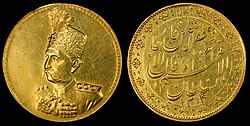Toman

The toman (also Tomaund or Tomond ) was an old Persian gold coin that originally resembled the ducat .
It was divided into 10 cranes of 2 panabats of 10 shahi (4 shāhi corresponded to one Abbāsi or 200 dinars ) and legally contained 3.376 g of fine gold .
As a toman ( Persian تومان Tumān orتومن Tuman ) are now called ten, ten thousand or even ten million Iranian rials ,depending on the context. The term Toman does not appear on the banknotes or coins.
There is one more thing you should know about the Iranian currency . Due to the fact that both toman and rial have a lot of zeros, the Persians came up with a different way of talking about prices. People will drop another three zeros and tell you the price. For example, if it is 70,000 rials, the seller will not tell you that it is 7,000 tomans. He will tell you that there are 7 tomans.
In street shops and in the bazaar, one toman is equivalent to ten rials.
In 2008 the Iranian central bank announced plans to carry out a currency reform and to name the new currency after the toman. The conversion should take place in a ratio of 1: 10,000. As a first step towards this currency cut, the central bank introduced two traveler checks in the summer of 2008, denominated for 500,000 and one million Iranian rials, but with the numbers “50” and “100” stamped on them. These papers, dubbed travelers checks, are used in everyday life like ordinary banknotes.
Individual evidence
- ^ Bozorg Alavi and Manfred Lorenz : Textbook of the Persian language. Langenscheidt, Leipzig etc. 1967, 7th edition, ibid 1994, ISBN 3-324-00253-2 , p. 267
- ↑ Iran Currency - A Guide To Iran Travel Cost | IranAmaze. June 10, 2020, accessed on June 13, 2020 .
